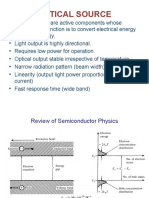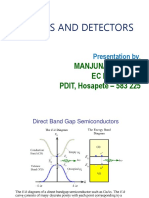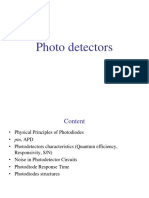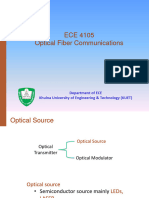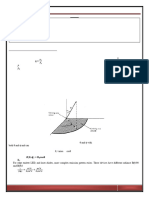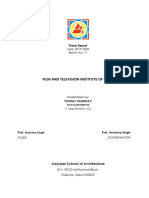LED Class
LED Class
Uploaded by
shubham saurabhCopyright:
Available Formats
LED Class
LED Class
Uploaded by
shubham saurabhOriginal Title
Copyright
Available Formats
Share this document
Did you find this document useful?
Is this content inappropriate?
Copyright:
Available Formats
LED Class
LED Class
Uploaded by
shubham saurabhCopyright:
Available Formats
Light-Emitting Diodes (LEDs)
For photonic communications requiring data rate 100-200 Mb/s
with multimode fiber with tens of microwatts, LEDs are usually
the best choice.
LED configurations being used in photonic communications:
1- Surface Emitters (Front Emitters)
2- Edge Emitters
Edge-Emitting LED
Schematic of an edge-emitting double heterojunction LED. The output beam is
lambertian in the plane of junction and highly directional perpendicular to pn junction.
They have high quantum efficiency & fast response.
Optical Fiber communications, 3rd ed.,G.Keiser,McGrawHill, 2000
Light Source Material
Most of the light sources contain III-V ternary & quaternary
compounds.
Ga 1 x Al x As by varying x it is possible to control the band-gap
energy and thereby the emission wavelength over the range of
800 nm to 900 nm. The spectral width is around 20 to 40 nm.
In1 x Ga x As y P1 y By changing 0<x<0.47; y is approximately 2.2x,
the emission wavelength can be controlled over the range of
920 nm to 1600 nm. The spectral width varies from 70 nm to
180 nm when the wavelength changes from 1300 nm to 1600
nm. These materials are lattice matched.
Spectral width of LED types
Optical Fiber communications, 3rd ed.,G.Keiser,McGrawHill, 2000
Rate equations, Quantum Efficiency & Power of
LEDs
When there is no external carrier injection, the excess density
decays exponentially due to electron-hole recombination.
n(t ) n0 e t /
n is the excess carrier density,
n0 : initial injected excess electron density
: carrier lifetime.
Bulk recombination rate R:
dn n
dt
Bulk recombination rate (R)=Radiative recombination rate +
nonradiative recombination rate
bulk recombination rate ( R 1/ )
radiative recombination rate ( Rr 1/ r ) nonradiative recombination rate( Rnr 1/ nr )
With an external supplied current density of J the rate equation for the electron-hole
recombination is:
dn(t ) J n
[4-6]
dt
qd
q : charge of the electron; d : thickness of recombination region
In equilibrium condition: dn/dt=0
J
n
qd
[4-7]
Internal Quantum Efficiency & Optical Power
nr
Rr
int
Rr Rnr r nr r
int : internal quantum efficiency in the active region
Optical power generated internally in the active region in the LED is:
I
hcI
Pint int h int
q
q
Pint : Internal optical power,
I : Injected current to active region
External Quantum Eficiency
ext
# of photons emitted from LED
# of LED internally generated photons
[4-10]
In order to calculate the external quantum efficiency, we need to
consider the reflection effects at the surface of the LED. If we
consider the LED structure as a simple 2D slab waveguide, only
light falling within a cone defined by critical angle will be emitted
from an LED.
ext
T ( )(2 sin )d
4 0
4n1n2
T ( ) : Fresnel Transmissi on Coefficient T (0)
(n1 n2 ) 2
If n2 1 ext
1
n1 (n1 1) 2
Pint
LED emitted optical powr, P ext Pint
n1 (n1 1) 2
Modulation of LED
The frequency response of an LED depends on:
1- Doping level in the active region
2- Injected carrier lifetime in the recombination region, i .
3- Parasitic capacitance of the LED
If the drive current of an LED is modulated at a frequency of
the output optical power of the device will vary as:
P ( )
P0
[4-15]
1 ( i ) 2
Electrical current is directly proportional to the optical power,
thus we can define electrical bandwidth and optical bandwidth,
separately.
p()
I()
20
log
I (0)
p
(
0
)
p : electrical power, I : electrical current
Electrical BW 10log
[4-16]
You might also like
- VTU BCHES102 Question BankDocument4 pagesVTU BCHES102 Question BankAbhishek Rai80% (5)
- Unit IIIDocument46 pagesUnit IIIkumarnath jNo ratings yet
- L17 LED PartDocument25 pagesL17 LED Partsvedika18No ratings yet
- Chapter 6 LEDDocument17 pagesChapter 6 LEDYohannesNo ratings yet
- Light Emitting Diode (LED) LASER Diode Photo TransistorDocument58 pagesLight Emitting Diode (LED) LASER Diode Photo TransistorQuazi Mosaddequl HaqueNo ratings yet
- Lecture20 Semiconductor Lasers 1Document42 pagesLecture20 Semiconductor Lasers 1Mohammed HushamNo ratings yet
- Optical SourceDocument46 pagesOptical Sourcemanishsoni30100% (1)
- JU Fiber 4 TXDocument68 pagesJU Fiber 4 TXamjadtawfeq2No ratings yet
- Light Sources For Optical Communications: Optical Communication Systems Xavier Fernando RCL LabDocument45 pagesLight Sources For Optical Communications: Optical Communication Systems Xavier Fernando RCL Labsamsim1232No ratings yet
- Fig. 4-1 - Pure-Crystal Energy-Band DiagramDocument11 pagesFig. 4-1 - Pure-Crystal Energy-Band DiagramTisha KhatriNo ratings yet
- 5th Unit Ofc MwocDocument106 pages5th Unit Ofc MwocSai AbhinavNo ratings yet
- PhotodetectorsDocument46 pagesPhotodetectorsShivam AgarwalNo ratings yet
- Unit-Iv Optical Source, Detectors and Amplifiers: Popular Semiconductors Used For Led FubricationDocument19 pagesUnit-Iv Optical Source, Detectors and Amplifiers: Popular Semiconductors Used For Led FubricationAbhijith SreekumarNo ratings yet
- Optical DetectorsDocument62 pagesOptical DetectorsGautam NarayanNo ratings yet
- Lect11-Semiconductor Lasers and Light-Emitting DiodesDocument182 pagesLect11-Semiconductor Lasers and Light-Emitting DiodesUgonna OhiriNo ratings yet
- Optoelectronics: Module-5 Laser SourcesDocument36 pagesOptoelectronics: Module-5 Laser SourcesJayanth VallabhaiNo ratings yet
- Chepter - 2Document60 pagesChepter - 2abdulsemedNo ratings yet
- Photo DetectorDocument50 pagesPhoto Detectormanishsoni30No ratings yet
- Sources and Detectors: Manjunatha. K. H. EC Department PDIT, Hosapete - 583 225Document77 pagesSources and Detectors: Manjunatha. K. H. EC Department PDIT, Hosapete - 583 225Manjunatha KurugoduNo ratings yet
- Photodetectors PIN and APDDocument47 pagesPhotodetectors PIN and APDkeziah rajNo ratings yet
- OpticalsourcesDocument38 pagesOpticalsourcesPonmalar SivarajNo ratings yet
- Optical Detector - RBDocument49 pagesOptical Detector - RBK. ogareNo ratings yet
- Source To Fiber Power LaunchingDocument80 pagesSource To Fiber Power LaunchingshivendraNo ratings yet
- Unit 3 Photodetectors_part2Document33 pagesUnit 3 Photodetectors_part2Sai Prithvi KammarNo ratings yet
- Ch4 (Compatibility Mode)Document46 pagesCh4 (Compatibility Mode)amanuel abrehaNo ratings yet
- Chapter 6Document136 pagesChapter 6vinothNo ratings yet
- Optical Receivers: Theory and OperationDocument48 pagesOptical Receivers: Theory and OperationHarshita MohapatraNo ratings yet
- Chapter-04 Modulation and Laser With ProblemsDocument105 pagesChapter-04 Modulation and Laser With Problemssohaib100% (1)
- Lec 2 - Features of Fibre OpticDocument21 pagesLec 2 - Features of Fibre OpticMtende MosesNo ratings yet
- 5 - LEDsDocument54 pages5 - LEDsAugustte StravinskaiteNo ratings yet
- Unit 5 Part1Document9 pagesUnit 5 Part1rahulkhannaNo ratings yet
- 2 Oed - M2Document27 pages2 Oed - M2Christy PollyNo ratings yet
- Optical Property of Leds and Implements: 2-1 Internal, Extraction, External and Power EfficienciesDocument9 pagesOptical Property of Leds and Implements: 2-1 Internal, Extraction, External and Power EfficienciesElons1973No ratings yet
- Oc Unit 3Document134 pagesOc Unit 3mohitha.kNo ratings yet
- Optic FibreDocument48 pagesOptic FibreSGSNo ratings yet
- EE 230: Optical Fiber Communication Lecture 9: Light SourcesDocument36 pagesEE 230: Optical Fiber Communication Lecture 9: Light SourcesmofiwNo ratings yet
- CH 8-Electrooptic Devices PDFDocument34 pagesCH 8-Electrooptic Devices PDFMohit SinghNo ratings yet
- Optical Communication SystemDocument42 pagesOptical Communication SystemProf.Vidya KeshwaniNo ratings yet
- OFC - Lec - LEDDocument27 pagesOFC - Lec - LEDfatmagulkerim19No ratings yet
- Turyahebwa Victor Bu Ug 2016 98Document11 pagesTuryahebwa Victor Bu Ug 2016 98Prossy NatuhweraNo ratings yet
- Ece477 6Document23 pagesEce477 6edwin7029No ratings yet
- Opt Comm C6Document46 pagesOpt Comm C6Arunmetha SundaramoorthyNo ratings yet
- Oc C UNIT-3-LEDDocument71 pagesOc C UNIT-3-LEDMannat MahajanNo ratings yet
- Tutorial 2Document2 pagesTutorial 2Titiksha Dharania 4-Year B.Tech. Electronics EngineeringNo ratings yet
- Set-5 Optical DetectorDocument16 pagesSet-5 Optical DetectorHatir HolNo ratings yet
- OC UNIT-5Document45 pagesOC UNIT-5nakkasrilakshmireddy2004No ratings yet
- Photo Diodes TransistorsDocument30 pagesPhoto Diodes TransistorsnumbrNo ratings yet
- Module 3 - Photodetector PDFDocument33 pagesModule 3 - Photodetector PDFJAYANTH KUMARNo ratings yet
- Photo DetectorsDocument47 pagesPhoto DetectorsShubham SinghNo ratings yet
- 8.LED CharactersticsDocument17 pages8.LED Charactersticsbishnupriya11kanungoNo ratings yet
- Semiconductor LaserDocument8 pagesSemiconductor LaserRaniKhannaNo ratings yet
- Organic Electronics - Photo Detectors and DiodesDocument72 pagesOrganic Electronics - Photo Detectors and Diodeshemanth.vishnu2002No ratings yet
- CH 6 PhotodetectorsDocument18 pagesCH 6 PhotodetectorsNikhil GuptaNo ratings yet
- Module 3Document96 pagesModule 3aditya shekhawatNo ratings yet
- unit-3_LED (1)Document56 pagesunit-3_LED (1)vpnmaster2612No ratings yet
- Semiconductor Sources For Optical CommunicationsDocument54 pagesSemiconductor Sources For Optical CommunicationslaptopNo ratings yet
- Module-3: Recombination in SemiconductorsDocument45 pagesModule-3: Recombination in Semiconductorsnidhi patelNo ratings yet
- Feynman Lectures Simplified 2C: Electromagnetism: in Relativity & in Dense MatterFrom EverandFeynman Lectures Simplified 2C: Electromagnetism: in Relativity & in Dense MatterNo ratings yet
- Organic Light-Emitting Transistors: Towards the Next Generation Display TechnologyFrom EverandOrganic Light-Emitting Transistors: Towards the Next Generation Display TechnologyNo ratings yet
- Analog Dialogue, Volume 48, Number 1: Analog Dialogue, #13From EverandAnalog Dialogue, Volume 48, Number 1: Analog Dialogue, #13Rating: 4 out of 5 stars4/5 (1)
- Experiment 5 OrificeDocument8 pagesExperiment 5 OrificeRazahamid904No ratings yet
- 4 Properties of FormaldehydeDocument120 pages4 Properties of FormaldehydeJonathan ByamunguNo ratings yet
- Wave and SoundDocument38 pagesWave and SoundCorazon JacksonNo ratings yet
- 9.16. Prepare A Plot of Work Per Pound Mole Versus The Pressue Ratio PDocument6 pages9.16. Prepare A Plot of Work Per Pound Mole Versus The Pressue Ratio PttussenoNo ratings yet
- A Study On Low Power Spintronics: Reshma Sinha, Jasdeep KaurDocument6 pagesA Study On Low Power Spintronics: Reshma Sinha, Jasdeep Kaurarjun raghavan.vNo ratings yet
- Ferrous MetalDocument26 pagesFerrous MetalEdbert TulipasNo ratings yet
- Muschen BroekDocument24 pagesMuschen BroekArdy25No ratings yet
- Detailed Inspection Report On 12 Inches Obigbo Sales Manifold - NGCDocument38 pagesDetailed Inspection Report On 12 Inches Obigbo Sales Manifold - NGCBethelSilasNo ratings yet
- Mununga Day Secondary School: Candidate'S Name: ClassDocument3 pagesMununga Day Secondary School: Candidate'S Name: ClassSimon SimuntalaNo ratings yet
- Paper 1Document6 pagesPaper 1Giuma AbudagelNo ratings yet
- New Microsoft Excel WorksheetDocument4 pagesNew Microsoft Excel Worksheetvenu manikantaNo ratings yet
- Maflowrap Medium Duty TapeDocument2 pagesMaflowrap Medium Duty TapeNoel MJNo ratings yet
- SpringsDocument31 pagesSpringsyoussef.mahmoud031No ratings yet
- Présentation STULZ - 111123 PDFDocument53 pagesPrésentation STULZ - 111123 PDFIssam Ouechtati100% (1)
- Fundamentals of Geological and Environmental Remote Sensing: TTTTTTTTTTTT?Document6 pagesFundamentals of Geological and Environmental Remote Sensing: TTTTTTTTTTTT?Luis Jael Cota ValdezNo ratings yet
- Chapter5 Shella Eva - TKPDocument28 pagesChapter5 Shella Eva - TKPshellaeva0960No ratings yet
- 0.4"alphanumeric LED Displays: LTP-4323/4823 SeriesDocument4 pages0.4"alphanumeric LED Displays: LTP-4323/4823 Seriesoswado gomez monroyNo ratings yet
- Class Vii SS WS 4Document2 pagesClass Vii SS WS 4neelufuransari2018No ratings yet
- Machine ElementsDocument4 pagesMachine Elementsdonjon019No ratings yet
- Failure Analysis of Pressure VesselDocument5 pagesFailure Analysis of Pressure Vesseltumoye100% (1)
- Astm A1014Document3 pagesAstm A1014Shunmugavel KarpagamNo ratings yet
- Expt 1 - Reynolds NumberDocument5 pagesExpt 1 - Reynolds NumberJoshuaNo ratings yet
- A Simple Mathematical Model For Slug Liquid Holdup in Horizontal PipesDocument8 pagesA Simple Mathematical Model For Slug Liquid Holdup in Horizontal PipesPrashantNo ratings yet
- FUTO Post UTME Past Questions 2005 2006 - 2010 2011Document29 pagesFUTO Post UTME Past Questions 2005 2006 - 2010 2011Dider DrogbaNo ratings yet
- Vectors: Reinz Eric Merabite Shaira Mae Frogosa Carl Zyann Rabino Doanne MusaDocument6 pagesVectors: Reinz Eric Merabite Shaira Mae Frogosa Carl Zyann Rabino Doanne MusaElla MallorcaNo ratings yet
- Final Thesis Report - Yuvraj VaishnavDocument38 pagesFinal Thesis Report - Yuvraj VaishnavAnkit Kashmiri GuptaNo ratings yet
- Engineering Guidelines Annexes - 2015Document109 pagesEngineering Guidelines Annexes - 2015Bibo KhoNo ratings yet
- Thermophysical Properties Evolution of French Partly Baked Bread During FreezingDocument12 pagesThermophysical Properties Evolution of French Partly Baked Bread During FreezingAnh NguyễnNo ratings yet
- Electro Statics - Balaji PaperDocument2 pagesElectro Statics - Balaji PaperKrishna Vijay Kumar GangisettyNo ratings yet

